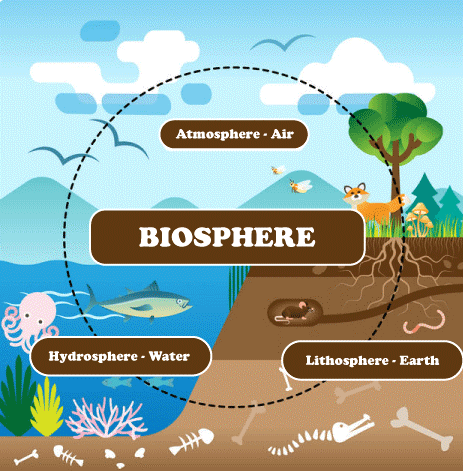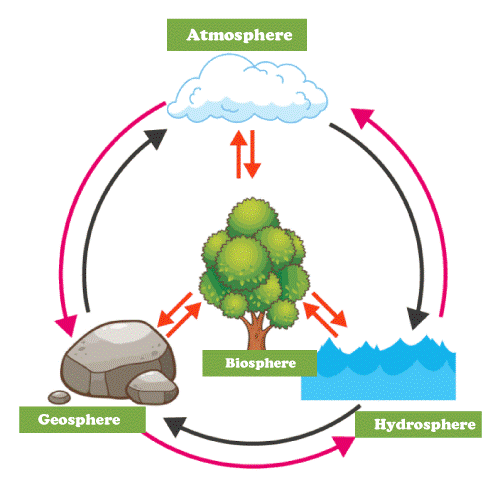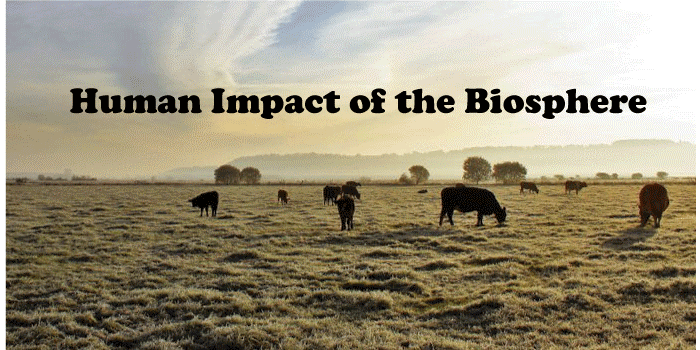Biosphere DefinitionThe biosphere provides the conditions necessary for survival. For living things to survive, they must adapt to the surroundings of the biosphere. The biosphere is essential for human life because it is a zone where the hydrosphere, lithosphere, and atmosphere interact. Those who live on the lithosphere, or land, construct structures for shelter, cultivate crops for food and fiber, gather minerals, and maintain forests. The biosphere is crucial because it is the home of all life. Without the biosphere, Earth would be devoid of life. When natural resources are destroyed more quickly, human instability rises. We must figure out a sustainable method to utilize our ecosystem. What is Biosphere?The biosphere is the region of the Earth where the atmosphere, hydrosphere, and lithosphere all interact. All living things and the byproducts of their activity are included in the biosphere, which is a geographical region. Therefore, it has a crucial role in keeping ecosystems healthy. The aggregate of all ecosystems is what is referred to as the Ecosphere. 
The area of life on Earth is also known as the biosphere. The Ecosphere is made up of a system that includes the biosphere, atmosphere, geosphere, and hydrosphere. Even in the deepest hole, life may be found in the biosphere of the Planet (Mariana Trench). It has life in some kind from the arctic ice caps to the equator. There are various biomes in our biosphere. A variety of flora and animals live there in a sizable region. For example, Forest or tundra. Elements of the BiosphereThe lithosphere, atmosphere, and hydrosphere are all components of the biosphere, which is where life on Earth is found. It consists of the regions of the world where there is life, including plant and animal life, in addition to human life. It consists of everything from grassland to deep woods, rain forests to the ocean, and mountains to plains. 
LithosphereIt is the part of the biosphere that is composed of solid ground masses, such as continents and islands. The only areas of it that cannot support life and are thus not a part of the biosphere are its lower mantle and core. From the smallest bacteria to the biggest animals and enormous trees, everything else sustains life by providing it with shelter and food. AtmosphereThe atmosphere is a gaseous layer that covers the Planet. To aid living things like plants, people, and other animals in survival, the atmosphere is made up of a variety of gases, including oxygen, carbon dioxide, and others. The atmosphere, a part of the biosphere, especially protects living organisms from the sun's harmful UV radiation in addition to supplying gases for respiration. Because there is not much oxygen in the upper atmosphere, flying birds can be seen at altitudes of less than 200 meters. HydrosphereAll of the liquids on Earth are referred to as the hydrosphere. It is therefore sometimes referred to as the aquatic area. Yet there are also substantial structures there, like glaciers. The hydrosphere is essential for regulating Earth's temperature since it sustains life. It also supplies water, which is essential for all living things. Biosphere ResourcesThe biosphere supplies crucial materials. Food, medicine, construction materials, and fuel are just a few of the necessities that many people rely on from the biosphere. With the exception of salt, all food is a product of the biosphere, although advanced cultures prefer farming over foraging. The biosphere, a relatively small area of the Earth's surface that extends from deep marine vents to a few kilometers into the sky, sustains life. The biosphere is a huge ecosystem that consists of both living beings (biotic) and the inanimate objects (abiotic) that sustain them. What is the Biosphere's Importance?The biosphere connects how living things interact with their surroundings. An environmental change, no matter how slight, may significantly impact the lives of living creatures. But because of this link, the biosphere is essential for all life. A few of them are listed below: 
The biosphere offers the necessary ecology for survival. Living things ought to be able to adapt to the climate of the biosphere. Every life on Earth receives a reliable supply of nutrients from the biosphere and ecosystems, which support biodiversity. Biosphere reserves are regulated areas for the preservation of flora and animals. The word "biodiversity" refers to biological variation. Also, it helps the native tribes preserve their traditional way of life. They protect the local biodiversity. The biosphere represents the highest ecological level. It has every kind of creature and every sort of biome on the globe. The biosphere, a little area of the planet's surface where soil, water, and air work together to support life, is one of the planet's most important ecosystems. The biosphere contributes to the regulation of the hydrological (water) cycle, soil quality, and atmospheric composition, which maintains life on Earth. Only here is life even imaginable. Biospheres ExamplesThe area where living things live is called the biosphere, including the air and the ground. It is referred to as the region where life may be found on, above, and below the surface of the Earth. The Ecosphere is another name for it. All living things have it as their natural environment. It is composed of the lithosphere, the hydrosphere, and a lower layer of the atmosphere. It also gives humanity the means by which they have developed and altered the natural environment to suit their requirements. For instance, the soil serves as the foundation for agriculture, while the river provides us with water. All living creatures depend on it to survive. The biosphere is the name given to the entire biological system. It covers every kind of life that exists on Earth as well as every setting that can sustain life. Each of the biomes that make up the biosphere has its own own climate, adaptations, vegetation, and wildlife. Photosynthesis serves as the main source of energy for ecological processes. Biosphere Facts
Zones of BiosphereThree zones are used to categorize biosphere reserves: 
Core ZoneThe natural zone, often known as the core zone, is off-limits to human activities. Outsiders are not permitted in this area, which is reserved for the reservation. Buffer ZoneThe buffer zone is the region around the core zone. Legal activities like study and teaching are allowed here, along with a little tourism and fishing. Manipulating ZoneThe manipulation zone, sometimes called the Transition zone, is the region closest to the biosphere reserve. Here, with the assistance of the local population and management, human activities like farming are carried out without endangering the ecology. The forestry, tourism, and restoration regions are only a few of the aspects of this zone. Characteristics of the BiosphereThe biosphere provides the ecosystem necessary for organisms to survive. It is crucial to the maintenance of life on Earth. It is a crucial element of the air conditioning control. The biosphere's climate is something that living things should be able to adapt to. Food is only available on Earth from the biosphere. Biosphere regions are places that are safe for both plant and animals. They safeguard the region's biodiversity. This encompasses both biomes and all living things. Also, it aids in the preservation and restoration of local tribal customs. 
How long living things endure might be greatly impacted by environmental change. Through assisting in the regulation of the water cycle, soil quality, and chemical make-up of the atmosphere, the biosphere acts as the planet's life support system. It gauges the value that a biome contributes. In addition to supplying food and raw materials, it aids in the recycling of nutrients and encourages the continuity of life on Earth. Life will endure on Earth if people can adapt to the ecology. Characteristics of a Healthy BiosphereThe following are crucial elements of a successful biosphere reserve: ConservationThe preservation of endemic species, resources, ecosystems, and landscapes is the main goal of an effective strategy for the conservation of natural resources. Also, it defends the morals and cultures of several tribes. Deforestation and wildlife hunting is forbidden. DevelopmentIt emphasizes the development of sociocultural, economic, and ecological systems. It enhances sustainable development operations while also protecting the environment. Logical SupportThey serve as locations for research and educational instruction. They provide examples of legislation and keep track of conservation and sustainable development on a local, national, and global scale. AwarenessIt should raise public awareness of the value of preserving the biosphere and the necessity of saving various plant and animal species. It must engage in global networking and adhere to the proper zonal layout. By emphasizing the participation and growth of local communities, it should also concentrate on a multi-stakeholder approach. The Biosphere and HumansAny areas of the Planet that are inhabited by living things, such as plants, animals, and microbes, as well as the water and soil in which they thrive, are collectively referred to as the biosphere. Many essential items for human survival are produced by living things, including:
FoodMost people indirectly obtain their food from the biosphere through farm-raised meat, fruit, grains, vegetables, and other crops. Some people gather their food directly from the biosphere via fishing, hunting, or trapping. Moreover, tanks or pens can be used to grow fish. MedicineThere are several plants that have therapeutic properties that help humans stay healthy and treat ailments. Plant species from the tropical rainforest have been used to make over 7000 different medications. Building MaterialMaterials for Construction Humans employ earthen materials like clay and wood from trees to build with. FuelFor heating and cooking, a large number of people across the world rely on plants and animals. Burning wood and dried animal dung are both acceptable fuel sources. Animal fat, such as seal blubber, is utilized in oil lamps. Parts of the biosphere are also mined for fossil fuels. Biosphere Exploitation by Human Beings
Businesses use the biosphere for financial advantage. The extent of exploitation of the biosphere is expanding as a result of improved technology and rising demand. EnergyThe biosphere is being harmed by oil extraction in arctic regions like Northern Alaska because pipelines impact the permafrost. The need for energy resources rises as the population and wealth levels rise. Vast tracts of forest have also been exploited for coal, submerged by massive hydroelectric power projects, and utilized to cultivate crops that can be turned into biofuels. WaterGroundwater sources may get contaminated as a result of the growing interest in fracking. Water, A growing population is causing an over-extraction of water for drinking, agriculture, and washing from lakes, rivers, and aquifers. The biosphere is impacted when there is not enough water for plants and animals to exist. MineralsIn constructing buildings and manufacturing electrical products like mobile phones, minerals like gold and iron are employed. Mining is used to extract these minerals. Deforestation by mining in tropical rainforests causes the release of poisonous chemicals into streams and rivers, which destroy animals. Man, and Biosphere Programme (MAB)In order to improve the bond between people and the environment, the UNESCO Man and Biosphere Programme (MAB) was established as an intergovernmental scientific initiative in 1971. It provides environmental, social, and economic research in an effort to enhance human life and safeguard both natural and man-made ecosystems. It supports socially and culturally appropriate and advantageous theories and methods that support economic and sustainable growth. ConclusionThe biosphere provides the necessary conditions for survival. For living things to survive, they must adapt to the biosphere's environment. The biosphere is essential to human life as it is a zone of interaction between the hydrosphere, lithosphere, and atmosphere. Humans construct structures for shelter, cultivate crops for food and fiber, gather minerals, and create forests on the lithosphere, or land, where they also reside. The biosphere is equally essential to life since it encompasses all life. The biosphere is essential to life on Earth. Natural resource depletion and human instability are both rising. We must determine the most sustainable approach to utilize our environment.
Next TopicBiotechnology Definition
|
 For Videos Join Our Youtube Channel: Join Now
For Videos Join Our Youtube Channel: Join Now
Feedback
- Send your Feedback to [email protected]
Help Others, Please Share









